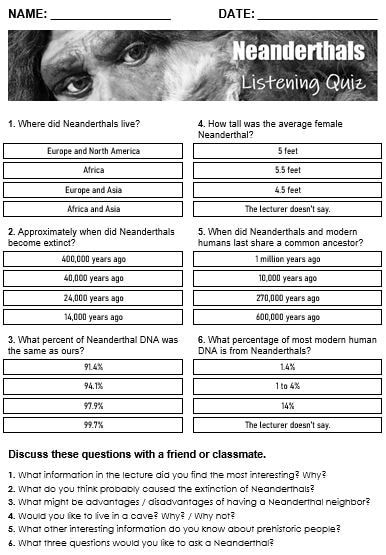Free printable PDF lesson plans, word banks, quizzes and games for EFL/ESL teachers
ADVANCED LISTENING PRACTICE
NEANDERTHALS
NEANDERTHALS
Audio Script
In today's lecture, we'll take a brief introductory look at our closest cousins on the evolutionary tree, the Neanderthals. In recent decades, new discoveries and research have uncovered a great deal of new evidence about Neanderthals which has changed the way we now think about them. As it turns out, they are much more than the simple, subhuman cavemen that we once thought them to be.
As you may already know, the Neanderthal is an extinct species of human that lived in Europe and Asia from around 400,000, to 40,000 years ago. They are closely related to modern humans. In fact, genetic analysis shows that Neanderthal DNA is 99.7% identical to present-day human DNA. They are considered to be a separate subspecies of Homo sapiens, known as Homo sapiens neanderthalensis.
Neanderthals were robustly built, with a large skull, strong jaw, and prominent brow ridges. They were also significantly shorter, and more muscular, than modern humans, with an average height of around 5 feet 5 inches for males, and 5 feet for females. Surprisingly, they had a large brain size, which was even larger than that of modern humans. They were also skilled hunters, capable of bringing down large game animals such as ice-age mammoths and bison, using stone tipped spears. Indeed, they were skilled at making a variety of stone tools including hand axes, flint knives, and scrapers. Contrary to popular belief, they also ate plant foods, and used fire for cooking.
Neanderthals were also capable of complex behavior, such as burying their dead with ritual and symbolic artifacts. Evidence suggests that they may have had a form of language. They also had a strong social structure and were able to adapt to a wide range of environments, from warm Mediterranean climates to the harsh conditions of Ice Age Europe.
Despite their similarities to us, Neanderthals were not direct ancestors of modern humans. Instead, it is believed that we shared a common ancestor, that lived around 600,000 years ago. The two species eventually diverged and evolved along separate lines, with modern humans eventually replacing the Neanderthals.
The exact reason for the Neanderthal extinction is still debated among scientists, but it is believed that a combination of factors, including climate change, competition with modern humans, and possibly disease, may have contributed to their demise. Yet, are they really extinct? Genetic studies have shown that some interbreeding between Neanderthals and our own species did occur, tens of thousands of years ago. As a result, the DNA of most people alive today, is between 1%, and 4%, Neanderthal.
In today's lecture, we'll take a brief introductory look at our closest cousins on the evolutionary tree, the Neanderthals. In recent decades, new discoveries and research have uncovered a great deal of new evidence about Neanderthals which has changed the way we now think about them. As it turns out, they are much more than the simple, subhuman cavemen that we once thought them to be.
As you may already know, the Neanderthal is an extinct species of human that lived in Europe and Asia from around 400,000, to 40,000 years ago. They are closely related to modern humans. In fact, genetic analysis shows that Neanderthal DNA is 99.7% identical to present-day human DNA. They are considered to be a separate subspecies of Homo sapiens, known as Homo sapiens neanderthalensis.
Neanderthals were robustly built, with a large skull, strong jaw, and prominent brow ridges. They were also significantly shorter, and more muscular, than modern humans, with an average height of around 5 feet 5 inches for males, and 5 feet for females. Surprisingly, they had a large brain size, which was even larger than that of modern humans. They were also skilled hunters, capable of bringing down large game animals such as ice-age mammoths and bison, using stone tipped spears. Indeed, they were skilled at making a variety of stone tools including hand axes, flint knives, and scrapers. Contrary to popular belief, they also ate plant foods, and used fire for cooking.
Neanderthals were also capable of complex behavior, such as burying their dead with ritual and symbolic artifacts. Evidence suggests that they may have had a form of language. They also had a strong social structure and were able to adapt to a wide range of environments, from warm Mediterranean climates to the harsh conditions of Ice Age Europe.
Despite their similarities to us, Neanderthals were not direct ancestors of modern humans. Instead, it is believed that we shared a common ancestor, that lived around 600,000 years ago. The two species eventually diverged and evolved along separate lines, with modern humans eventually replacing the Neanderthals.
The exact reason for the Neanderthal extinction is still debated among scientists, but it is believed that a combination of factors, including climate change, competition with modern humans, and possibly disease, may have contributed to their demise. Yet, are they really extinct? Genetic studies have shown that some interbreeding between Neanderthals and our own species did occur, tens of thousands of years ago. As a result, the DNA of most people alive today, is between 1%, and 4%, Neanderthal.















